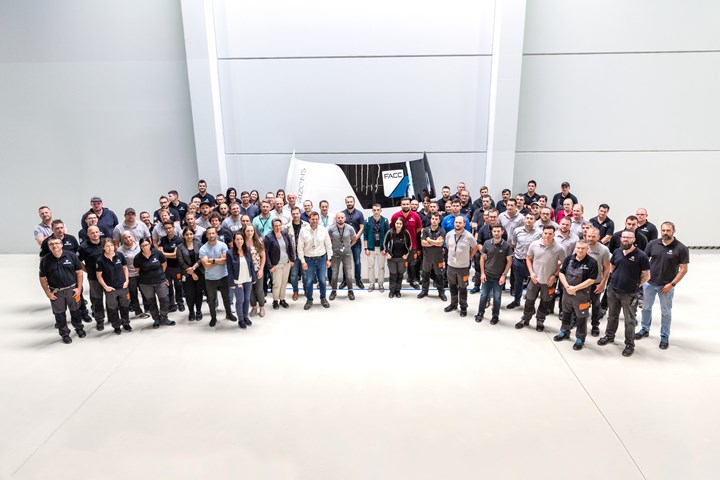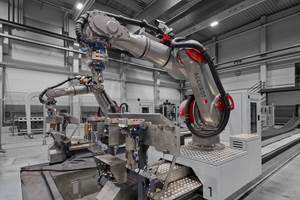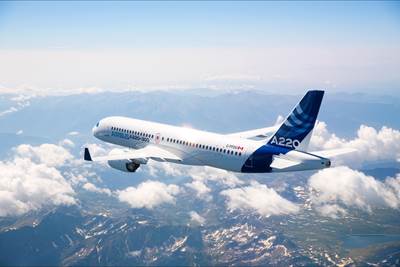FACC supplies 1,000th composite translating sleeve shipset for Airbus A350
Maximum investment in development and production of the lightweight components supports lower fuel consumption and significant reduction in CO2 emissions for the A350 family.

Photo Credit: FACC
With the aircraft industries swift recovery the last six months, FACC (Ried im Innkreis, Austria) has announced demand for new short- and medium-haul aircraft is up by 20% in Q4 2021. With long-haul aircraft, FACC is also celebrating a newly achieved milestone, with the deliverance of its 1,000th shipset of composite translating sleeves for the A350 to its customer, Collins Aerospace (Charlotte, N.C., U.S.).
FACC notes that composite components account for 50% of the Airbus A350’s weight, making it one of the most advanced and efficient aircraft on the market; 25% less fuel is consumed compared to its predecessors, and it’s also reported to be 60% quieter.
“With our years of know-how, we can provide both greater efficiency and lower noise emissions. This is our contribution to making flying more sustainable,” enthuses Robert Machtlinger, CEO of FACC. In order to occupy a strong market position as a pioneer in this field, the international aerospace group relies on cutting-edge technologies and innovative manufacturing concepts. “The first lightweight components for the translating sleeves of the Airbus A350 were delivered in 2010. Eleven years later, we are proud to be able to deliver the 1,000th translating sleeve shipset to our long-standing customer, Collins Aerospace,” he emphasizes.
According to Machtlinger, this success was not achieved overnight. Since the beginning of the project, FACC has invested approximately 50 million euros in the development and production of the components in order to offer Collins Aerospace and Airbus a translating sleeve that is as lightweight and fuel-efficient as possible, while gearing the production line towards maximum efficiency and ergonomics. Around 50 employees are currently working on the program.
“The long-haul segment is developing with a slight lag compared to the short- and medium-haul segment, but we expect the demand for A350 aircraft to continue to rise as the restrictions on transcontinental travel are gradually lifted,” explains Machtlinger.
Translating sleeves for the Airbus A350 family, are the main components of the thrust reverser. In addition to the outer parts of the thrust reverser and the movable blocker doors, they also contain the mechanical connecting elements required to operate these panels. Alongside the wing spoiler and the landing gear brakes, the thrust reverser is the third component in the brake system of modern commercial aircraft.
In this project, FACC says it has tailored the production line of lightweight components at Plant 4 in Reichersberg (Austria) towards maximum efficiency and, together with its customer Collins Aerospace, has incorporated technological innovations into the design of the translating sleeves. The use of newly developed composite materials generates considerable weight savings, which in turn result in lower fuel consumption and a significant reduction in CO2 emissions. At the same time, special acoustic treatment of the components means that significant noise emissions are directed from the engines to the exterior. “This anniversary delivery is a valuable confirmation of the cooperation with Collins Aerospace. I would like to thank our long-standing customer for their trust, and the FACC project team for their commitment and dedication throughout the entire project,” says Machtlinger.
Related Content
First Airbus A350 crash confirmed in Haneda
Shortly after touch-down, a JAL A350-900 aircraft recently collided with a De Havilland Canada Dash 8. Exact circumstances are still unknown.
Read MoreThe next-generation single-aisle: Implications for the composites industry
While the world continues to wait for new single-aisle program announcements from Airbus and Boeing, it’s clear composites will play a role in their fabrication. But in what ways, and what capacity?
Read MoreOtto Aviation launches Phantom 3500 business jet with all-composite airframe from Leonardo
Promising 60% less fuel burn and 90% less emissions using SAF, the super-laminar flow design with windowless fuselage will be built using RTM in Florida facility with certification slated for 2030.
Read MoreAutomated robotic NDT enhances capabilities for composites
Kineco Kaman Composites India uses a bespoke Fill Accubot ultrasonic testing system to boost inspection efficiency and productivity.
Read MoreRead Next
FACC expands partnership with Airbus
Expanded empennage component production for A220 family positions FACC as an important long-term technology partner to Airbus, supports the company’s growth strategy for the future.
Read MoreScaling up, optimizing the flax fiber composite camper
Greenlander’s Sherpa RV cab, which is largely constructed from flax fiber/bio-epoxy sandwich panels, nears commercial production readiness and next-generation scale-up.
Read MoreUltrasonic welding for in-space manufacturing of CFRTP
Agile Ultrasonics and NASA trial robotic-compatible carbon fiber-reinforced thermoplastic ultrasonic welding technology for space structures.
Read More


























